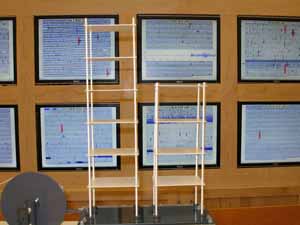Virtual
Tour > Intro > What Causes an EQ > How we locate EQ's > Equipment > Volcanoes > The End!
Shake Table

This small shaking table allows us to demonstrate how different
buildings react to different frequencies of earthquakes.
It also allows us to demonstrate how we can make buildings
safer in the event of an earthquake. Unfortunately, we cannot
show the motion of the buildings on the website (see The
End! if you want to arrange a real tour of the lab), but
have been able to take snapshots of the buildings' motion
and show what we can do to make buildings safer.
|
One of the ways we can help make buildings safer
is to make them react the same way as one another
during an earthquake. One of the dangers is that buildings
of two different sizes respond differently to the frequencies of the earthquake. This means
that when the shaking gets bad enough to cause damage,
buildings will actually start hitting each other and
destroying themselves. One could see evidence of this
from the Nisqually earthquake. The older buildings
in Pioneer Square in Seattle, as well as the older
buildings in downtown Olympia had this problem. (Picture by FEMA) |
 |
If the buildings shake simultaneously, then this reduces
the damaged caused by the earthquake. How can this be done?
If we follow the picture sequence below, we can see how
this works. In the first picture, we can see how the buildings
are colliding into each other when the shake table is turned
on. In the second picture, we add weight to the smaller
building so it behaves like the big building. This added
weight is making up for the two extra floors that the big
building has. If we now turn the shake table back on, we
can see in the third frame that they behave the same. While
it is difficult to capture the motion in a photograph, we
can see that they no longer collide (the shaking is turned
on to full power in the last photo).
The other way to reduce damage is to add giant rollers
to the bottom of the buildings. By placing rollers under
the foundation, we can see that there is virtually no shaking
of the buildings. The problem with this method is that it
is very expensive, and is even more expensive and very difficult
to do to buildings that have already been built. This method
has been used on a few landmark buildings here in Seattle.
Can you guess which ones? If you said the Safeco field
stadium and the new Seahawks stadium, then you're right. Underneath
their foundation lie giant rollers that keep the stadium
from shaking to a great degree from an earthquake. If we
look at the pictures below, this is once again demonstrated
by the shake table. Even though it is difficult to tell
in the picture on the right, one can see that the buildings
are barely moving.
Next>>>
|
|